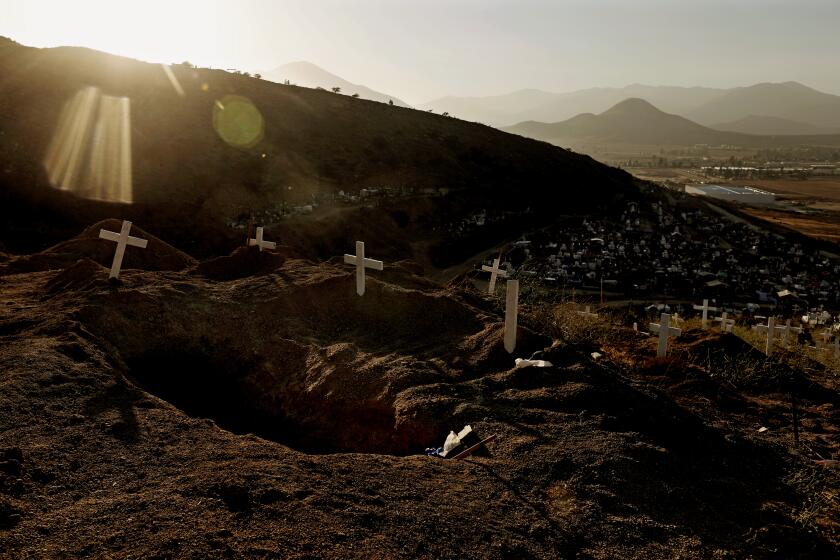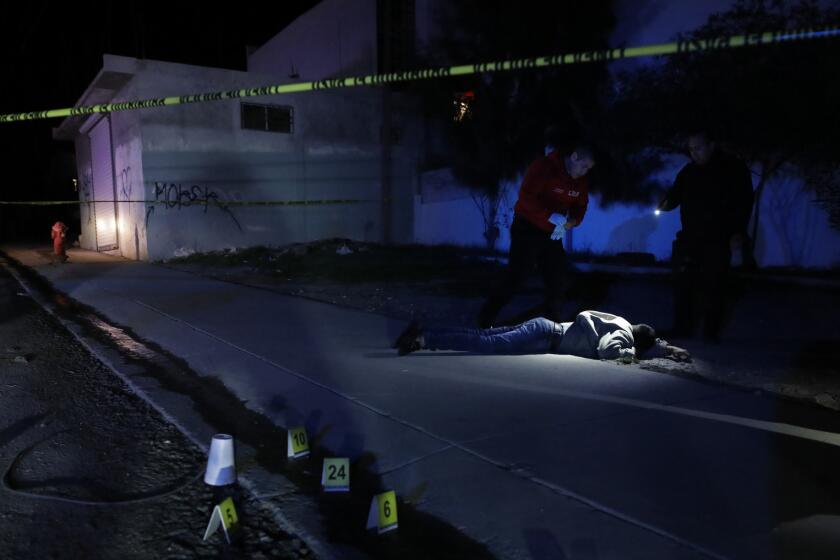Struggling to ID its dead, Mexico turns to Tennessee’s Body Farm

- Share via
KNOXVILLE, Tenn. — On a chilly fall morning here in eastern Tennessee, Raul Robles crouched alongside an open grave, surveying the bones his team had just unearthed.
He was unusually relaxed, bobbing his head to salsa music playing from his cellphone as he helped measure and map the assemblage of dirt-stained ribs and vertebrae.
Robles, 41, is used to much more harrowing conditions. Back in the Mexican state of Sinaloa, where he has excavated at least 500 clandestine graves during his 15 years as a crime scene investigator, he sometimes digs under surveillance from a drug cartel.
“The lookouts come on their motorcycles with no plates, with their lights turned off, and say, ‘You have two more hours to finish, or else,’” he said.
When that happens, he has little choice but to scoop the contents of the gravesite onto a tarp, throw it in his truck and finish his work back at the laboratory.
More than 93,000 people across Mexico are officially classified as missing — a staggering total that points to a crisis of not only violence but also forensics.
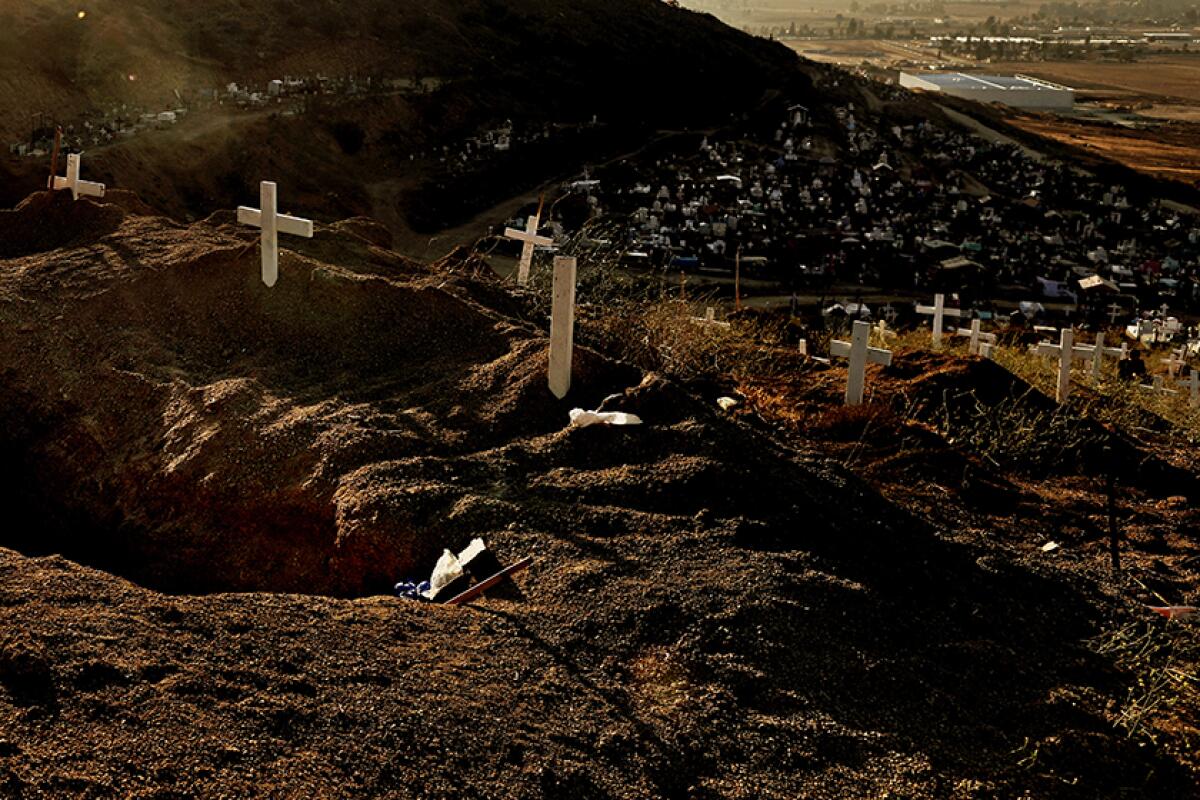
In recent years there has been a growing recognition that many of the missing may be in government custody — their bodies scattered among the tens of thousands of corpses that have passed through morgues without being identified and then buried in common graves. Mexican authorities have vowed to put names to the human remains in their care.
That is why Robles and 23 other Mexican crime scene investigators, forensic archaeologists and morgue workers spent five days last month at the University of Tennessee’s Forensic Anthropology Center, a world-famous research center better known as the Body Farm.
For more than four decades, researchers at the farm have been setting donated bodies on fire, immersing them in water, breaking their bones, rolling them up in carpets and leaving them in car trunks — all to learn more about how corpses decay in different conditions.
In the photograph, Arturo Figueroa Bonastre, decked out in hospital scrubs, smiles broadly.
Typically when they host visitors at the farm — a sloping 3-acre section of forest strewn with about 100 bodies in various states of decomposition — the researchers offer words of caution.
Take deep breaths, director Dawnie Wolfe Steadman tells them. And if you feel like you might faint, sit down on the ground.
The Mexican visitors, who lack training but not experience, required no such warnings.
::
In 1977, forensic anthropologist William Bass was summoned to a cemetery in Franklin, Tenn., where police had discovered what they assumed was a recent murder victim.
Bass came to the same conclusion, estimating that based on the body’s condition, the man had been dead for less than a year. He was off by more than a century.
The body turned out to be that of a Confederate soldier felled in the Battle of Nashville in 1864. Digging for anything of value, grave robbers had removed the corpse from a cast-iron coffin that had prevented its decomposition.
For Bass, it was a transformative moment. Science, he realized, understood very little about how bodies decompose.
Some 80,000 Mexicans have disappeared in the last 15 years. Many are now thought to be in government custody — among the thousands of corpses that pass through morgues each year without ever being identified and end up in common graves.
Soon the University of Tennessee, where he worked, had granted him a former dump site behind the medical school to experiment on donated corpses. After community protests erupted — “this makes us SICK” read one picketer’s sign — the university fenced the area with razor wire.
For years, Bass and his researchers operated in relative obscurity. Then in 1994 crime writer Patricia Cornwell published “The Body Farm,” a thriller loosely inspired by the facility, earning it both fame and a new nickname.
Today more than 5,000 people have registered to donate their bodies when they die. Researchers at the farm regularly serve as expert witnesses in murder trials and conduct trainings for the FBI.
When the U.S. government asked a few years ago if it could start sending Mexican teams to the farm to learn about forensic excavation, the researchers soon realized that they’d have to adapt their typical course.
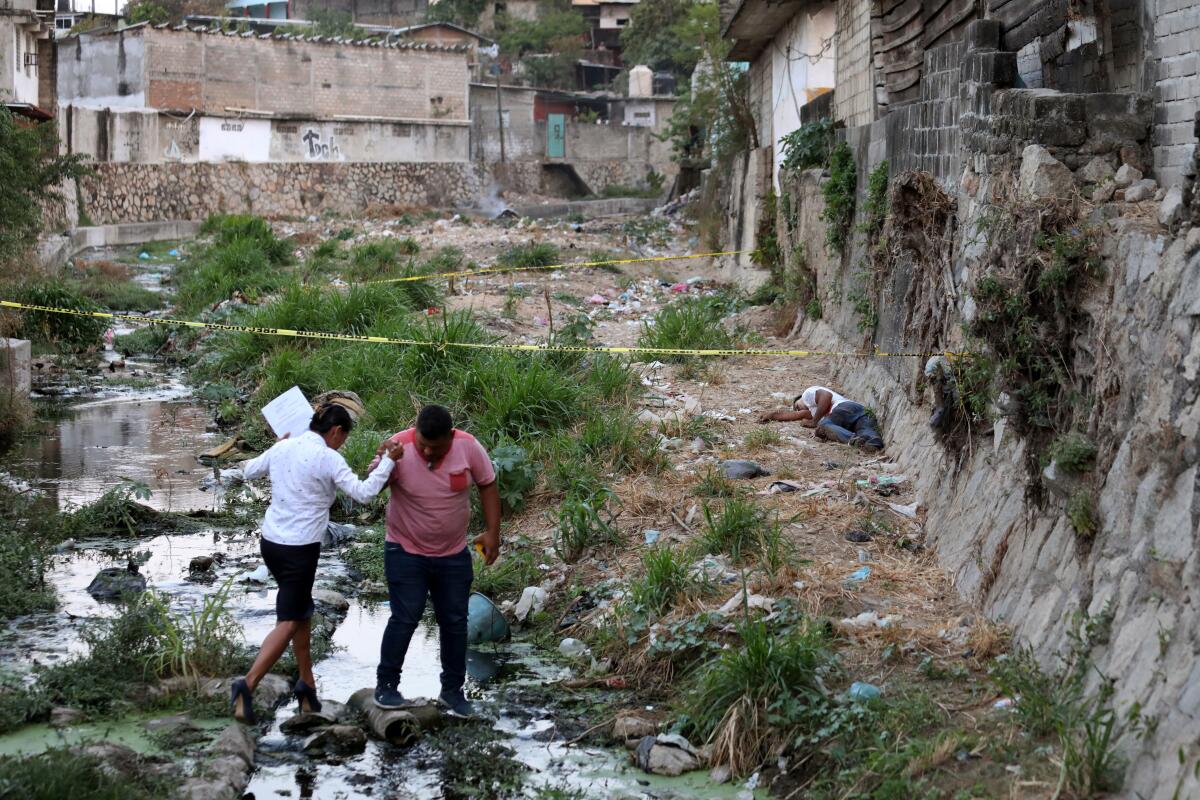
Simply put, Mexican investigators work under some of the most chilling and challenging conditions in the world.
“In one grave you might find three heads and five limbs,” Sandra Macías Gutiérrez, a morgue worker from the state of Colima, said over a lunch of pizza and soda during a break from class one day. “The narcos like to dismember the bodies they’ve already killed to make identifications really hard.”
Many parts of her country have not been at peace since 2006, when then-President Felipe Calderón declared war on the drug cartels, and killings and disappearances soared. The perpetrators — sometimes the narcos, sometimes corrupt police — began pioneering ever more barbaric forms of murder.
Many Mexicans closely associate the drug war with the United States, not only because of the vast American appetite for illegal drugs and the large numbers of firearms spilling south over the border, but also because the dramatic rise in violence coincided with a controversial and costly cross-border security partnership called the Mérida Initiative.
At the behest of Mexican President Andrés Manuel López Obrador, who says the warlike approach to drug trafficking turned Mexico into a “graveyard,” a new bilateral agreement is being negotiated.
U.S. officials say they will focus less on fortifying the Mexican military and adopt a “holistic” approach to public safety — targeting gun traffickers, funding drug treatment and supporting more forensic training programs like the one that brought the Mexicans to Tennessee.
::
Tensions that in recent years have strained the U.S.-Mexico relationship at the highest levels — including a claim by López Obrador that the U.S. fabricated a drug case against a former Mexican defense minister — were nonexistent on the farm.
The students and their teachers bonded over their love of bones, at one point crowding around a set of ribs whose owner had suffered from a rare disorder that caused parts of them to fuse together.
And they commiserated over the hit television show “CSI: Crime Scene Investigation,” which they agreed had spawned inaccurate expectations about the speed of forensic investigations.
The students spent the first two days in class, taking their seats each morning in a staid ballroom at the Hilton in downtown Knoxville for several hours of lectures.
They covered the science of decomposition and forensic entomology, learning how to approximate the time of death based on which insects are present. With the help of Spanish interpreters, they listened carefully as the instructors explained the best ways to retrieve evidence when a body has been burned.
By the third day, they were ready to get down in the dirt. They climbed into vans and rode across town to the Body Farm.
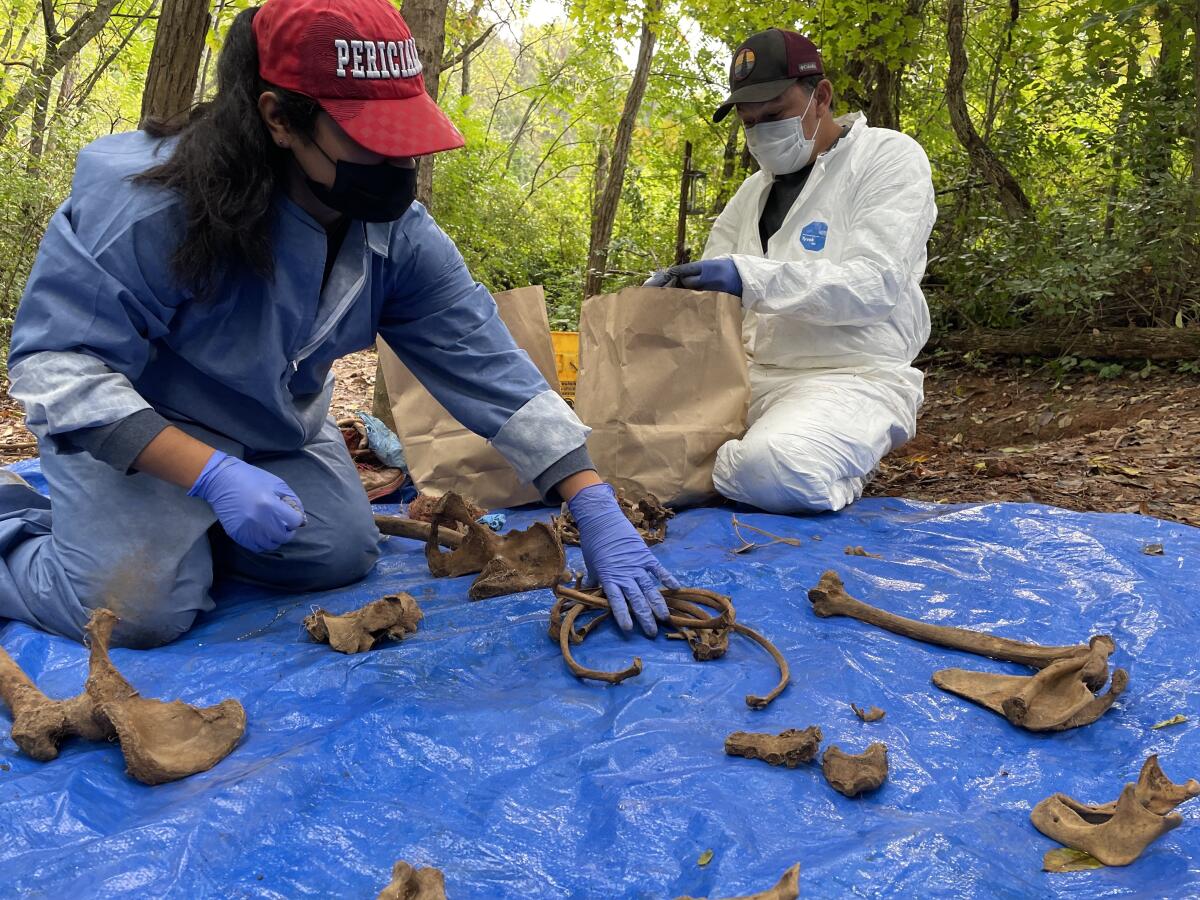
After donning puffy white hazmat suits and blue booties, they walked the grounds. Some of the bodies they passed were mummified, with leather-like skin clinging to their ribs. Others were still covered in blackened flesh. Most of their hands and feet had been covered with red plastic netting to protect them from the hungry raccoons that poke around here at night.
The cool, wet air meant the smell of decomposition was much less intense than it would have been during the sweltering months of summer.
The Mexicans broke into four teams, each of which would spend the coming days excavating a mock grave.
For a typical course, researchers bury a single, intact body. But this time, to replicate situations common in Mexico, they prepared more complex graves, disassembling several skeletons and burying them along with various pieces of evidence.
At one burial site, just next to a wooden gallows that researchers sometimes use to simulate hangings, several students quickly established a rectangular grid with stakes and string. Then they began deliberately removing the earth, eventually revealing a necklace, then a handgun and finally what appeared to be a femur.
Several stretched out on their stomachs as they swept away dirt with their fingers and tiny brushes. Every time they exposed a new layer — the deepest was about 4 feet — they stopped to map and photograph it.
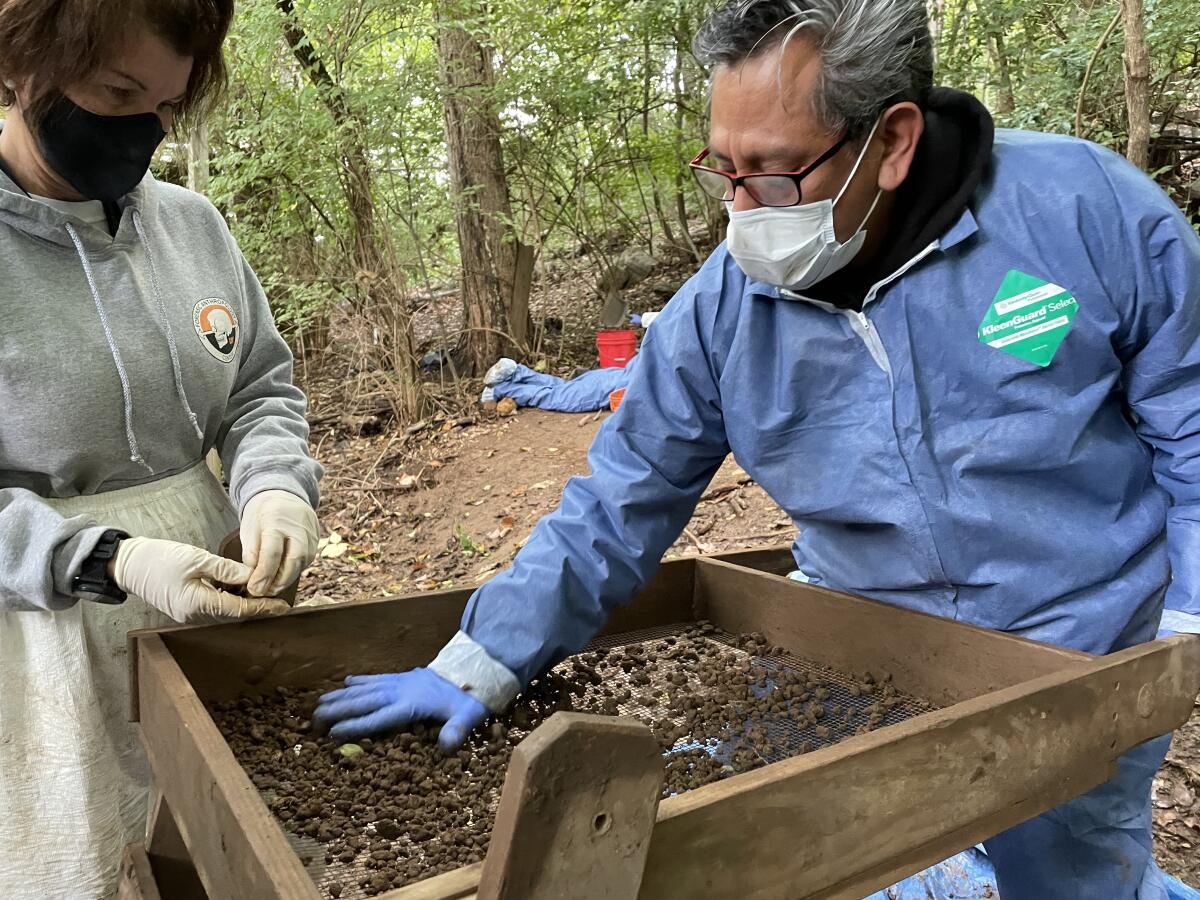
“We want to preserve the spatial relationship of different pieces of evidence with the body,” said Joanne Devlin, an associate director of the farm, who explained that preserving the specific timeline of when things were buried would be crucial for building a case later.
The Mexicans shared their own tips.
Isaac Aquino Toledo, 43, used small wooden stakes to hold the evidence in place while he worked, an unusual trick Devlin thought was genius.
“Sometimes I find the footprint of a shoe and then I find that same shoe on the victim,” said Aquino, a forensic anthropologist from the state of Hidalgo. “It’s usually because the killers made the victim dig their own grave.”
Later, as he was digging, he sighed: “I wish there was a better way to remove this dirt.”
“We need a forensic dustbuster,” Devlin said. “Invent one! You can retire!”
Along with teaching the best practices, the researchers demonstrated some shortcuts.
“If you don’t have time or it’s dangerous, you can use this method,” Mary Davis explained to a group of students, showing them that instead of measuring each bone in a grave they could approximate by drawing them on a grid.
At another gravesite, Carolina Montes, a forensic investigator from the city of Tepic in western Mexico, was sifting through dirt with a sieve.
She held up a small off-white object that looked like a pebble.
“Is it cartilage?” a friend asked.
“I think it’s a tooth,” Montes said, depositing it in a bag of evidence.
Montes, 26, said most forensic training programs in Mexico didn’t teach much about excavation and that people mostly learned on the job. She found that excavating the mock grave at the Body Farm was a lot easier than working back home.
“The grave is not very deep and the dirt is easy to dig through,” she said. “We’re used to graves with 10 people in them.”
::
When her students had finished their work, one of the teachers, Lee Meadows Jantz, took the bones they had recovered and laid them on a blue tarp. They would be cleaned, boxed and put in storage for future study along with roughly 1,600 other skeletons.
Then she asked her team a question: “Have you ever buried a body?”
Several people broke out in laughter — until they realized she was serious.
It is a ritual carried out at the end of most Body Farm training courses. Meadows Jantz had a partly decomposed corpse waiting, wrapped in a tarp, ready to be placed in a mock grave.
The Mexicans buried it under a barren honeysuckle along with a few pieces of evidence. “Throw in another shoe!” one yelled.
In the spring the honeysuckle would bloom with white flowers. In late summer, it would turn deep red. After several seasons, the body would become just bones — clues for other students to unearth.
That afternoon at a graduation ceremony at the hotel, the director thanked the students, telling them, “I feel that we have learned just as much from you.”
Each was given a small bag packed with trowels, brushes and other tools of the trade — items that are in short supply back home.
Often, Mexican forensic investigators have to buy supplies themselves because their departments are so underfunded. Sometimes tools are purchased by local collectives of families searching for their loved ones.
The collectives, which alert authorities to the location of possible graves, often stand watch during excavations, praying out loud for their sons or daughters to be found even as they dread such an outcome. It is not uncommon for investigators to work to the sound of wailing mothers.
“It’s very painful,” Montes said. “But I do this work so I can help people return to their homes.”
How to deal with those emotions is not something taught at the Body Farm.
Cecilia Sanchez in The Times’ Mexico City bureau contributed to this report.
More to Read
Sign up for Essential California
The most important California stories and recommendations in your inbox every morning.
You may occasionally receive promotional content from the Los Angeles Times.
